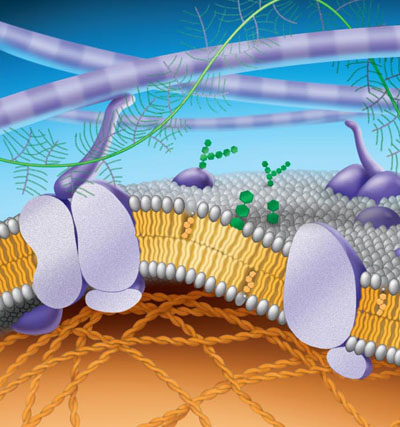
BIO 111: FOUNDATIONS OF BIOLOGY
LECTURE 3: "Cells I: Membranes"
THIS INFORMATION WILL NOT BE ON THE QUIZ - BUT I DISTRIBUTE IT TO MAKE IT AVAILABLE
FOR TUESDAY'S LECTURE.
Assumed Knowledge:
Chapter 6, from section 6.2 onwards; at the level of detail represented by
the questions, below.
Study Questions for Chapter 6 and Chapter 7:
- Why are cells small? Relate this to the functions of supply (surface area)
and demand (volume) for nutrients.
- What are the two major differences between prokaryote and eukaryote cells?
(Prokaryotes lack these...)
- What are the functions of these structures: nucleus, ribosomes, endoplasmic
reticulum, Golgi apparatus, lysosomes, mitochondria, choroplasts.
- What roles do actin microfilaments play in the cytoskeleton and cell motility.
- Draw a section through a cell membrane, showing the arrangement of the phospholipids
in the bilay and the arrangement of integral and peripheral proteins.
- How do unsaturated fatty acids and cholesterol molecules affect membrane
fluidity? How are these changes beneficial under hot or cold conditions?
- Describe the hydrophild and hydrophobic characteristics of the transmembrane
proteins.
- List six functions of membrane proteins.
- Where do small non-polar molecules like CO2, O2 pass through the membrane?
- Where do ions and large polar molecules pass through the membrane?
- Although water is a very small molecule, it does not pass readily across
the lipid bilayer because it is polar. Describe the structure of an 'aquaporin'
channel protein and explain its function in water transport across the membrane.
- Glucose is a large polar molecule. How does it cross the cell membrane?
- Define the relationships between these terms: passive transport, diffusion,
and osmosis.
- describe the net flow of water between a cell (9% saline solution) in a
15% saline solution. What if that cell is in a 3% saline solution?
- How does facilitated diffusion differ from simple diffusion?
- What is the difference between a channel protein and a carrier protein?
- What are the two major differences between active transport and facilitated
diffusion?
- Na+ ions move across membranes in response to theri electrochemical gradient,
not just their concentration graident...explain.
- One way that the membrane potential in all cells is established is the sodium-potassium
pump...drescribe how this works and establishes a charge diferential across
a membrane.
- A proton (H+) pump can also establish an electrochemical gradient that
can be used to do chemical work. How does a proton pump work?
- How does the 'cotransport' of sucrose workwork?
